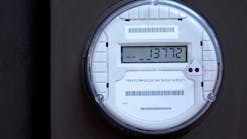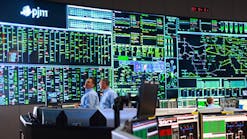Traditional streetlighting presents a significant burden on city resources by consuming up to 40% of municipal energy budgets. Furthermore, many cities still rely on manual processes to maintain their lighting assets, leading to inefficiencies in energy use and maintenance. Coupled with aging infrastructure and rising energy costs, this perfect storm creates an urgent need for more efficient solutions.
In cities worldwide, traditional streetlights are being upgraded with new LED technology and, at the same time, transformed into intelligent infrastructure that promises to reshape urban living. This transformation is especially crucial, as the World Economic Forum predicts that the world's population living in cities is expected to rise to 80% by 2050, from 55% now, and cities account for 70% of global carbon emissions, according to the United Nations. The intelligent infrastructure comes from the addition of a Networked Lighting Controller (NLC), which enables two-way data communications to the streetlight to collect critical data and provide real-time alerts.
The Smart Solution
The transition to “smart streetlights” provides cities with a pathway to significant improvements in both efficiency and functionality. By upgrading to LED technology, cities are achieving approximately 50% savings in energy costs. When enhanced with NLCs, they can realize up to an additional 30% in operational and energy savings through various optimizations. These savings come in multiple forms: reduced and optimized truck rolls (go to the right location, with the required equipment, in a single visit), fewer customer service calls (the light automatically reports problems before the citizens), customized dimming schedules (the right level of light at the right time to fit the conditions on the street) and fault detection in real-time (address the problem before it presents a public safety issue). The system also provides automated energy consumption measurement and dynamic adjustment capabilities, further enhancing efficiency.
Beyond Illumination
With ideal locations, density and power, modern smart streetlights serve as more than just sources of light; these intelligent systems offer an array of capabilities that transform urban management and sustainability.
In terms of environmental monitoring and sustainability, these systems provide continuous tracking of carbon emissions and air quality. They can detect temperature fluctuations to address “heat islands,” while also supporting smart irrigation and waste management solutions. This comprehensive environmental monitoring helps cities meet their sustainability goals while providing valuable data for future planning.
Traffic and transportation management benefits significantly from smart streetlight infrastructure. The systems monitor road conditions, pedestrian safety and vehicle patterns, enabling better traffic flow optimization and electric vehicle infrastructure integration. Cities can also monitor real-time parking availability to reduce congestion and enhance urban mobility.
Public safety sees substantial improvements through these intelligent systems. The streetlights can automatically identify and report faults, adjust lighting based on activity levels and detect incidents requiring response. They monitor noise levels and can identify damaged infrastructure, while also supporting emergency response systems (ERS) through improved coordination and communication.
Infrastructure management becomes more proactive with smart streetlight systems. They monitor flood risks and provide early warning alerts, track the condition of sewer and drainage systems and enable preventive maintenance scheduling. The integration with power grids allows for optimization of energy usage across the entire urban infrastructure network.
Real-World Implementation, Rapid Global Benefits
Cities achieve significant savings and typically recoup their investments in under 10 years. Beyond the immediate financial benefits, these systems provide valuable environmental advantages through reduced energy consumption and real-time carbon tracking capabilities. Providers in the industry have contracted over 25 million smart streetlights across multiple continents, demonstrating the scalability and practicality of these systems.
Direct energy cost savings can reach up to 50%, while operational costs decrease through automated maintenance and reduced manual inspection requirements. Reduced call center volume (citizen reports) and lower carbon footprint brings additional financial benefits. Moreover, the improved asset lifetime and performance contribute to long-term cost savings. Smart LED streetlights, with dimming capabilities via NLCs, allows for significant reduction in the number of make/models (e.g. wattage) of streetlights that the city or utility need to maintain, triggering another opportunity for operational cost reductions.
The combination of economic and environmental benefits makes smart streetlighting an attractive starting point for cities looking to build more sustainable and efficient urban environments. A few examples include:
- Paris led the global transition to smart LED streetlighting in 2015, upgrading 200,000 streetlights with LED luminaires, networked lighting controls, wireless communications and a central management system for dynamic lighting schedules. This success inspired France to replace over one-third of its seven million streetlights since 2016, with plans to complete the transition by 2030—aligned with the country's goal to reduce carbon emissions by 40%.
- Since 2022, the city of Fuengirola, Spain, has leveraged intelligent street lighting combined with noise detection and smart traffic monitoring solutions to create a more efficient, comfortable and sustainable environment for its citizens. The city has witnessed significant improvements in pedestrian and cyclist safety, while also optimizing traffic flow and enhancing its environmental monitoring capabilities.
- Christchurch, New Zealand, is modernizing its infrastructure by upgrading 45,000 legacy streetlights with efficient LED luminaires and smart control systems. This initiative supports the city's carbon neutrality target for 2045 while promising annual savings of NZ$2.1 million in electricity and maintenance costs.
- As part of the City of Chicago’s Smart Street Lighting Project, the City modernized more than 280,000 streetlights with smart LEDs. This initiative, the largest city-led wireless smart streetlight program in the U.S., has enabled Chicago to significantly reduce energy consumption and maintenance costs while enhancing public safety. The project has also delivered substantial financial benefits, with the City receiving over $34 million in rebates to date and projecting $100 million in savings over the first ten years.
While upgrading to LED bulbs alone reduces energy consumption by approximately half compared to legacy technologies, the full potential lies in smart lighting control integration. Adding networked lighting controls enhances energy savings by 10% to 30%, enables real-time electricity consumption monitoring and carbon reduction measurement, and creates infrastructure for equity and smart city initiatives. These Networked Lighting Controls consist of sensors installed on each luminaire, enabling advanced functionality, electricity metering and communication with back-office software systems.
The Gateway to Connected Communities
The latest LED streetlight networks reduce energy consumption and serve as platforms for environmental sensors, revealing stark disparities in urban heat exposure. According to EPA data, lower-income neighborhoods are often several degrees warmer than wealthier areas due to fewer trees and a higher prevalence of heat-absorbing surfaces. Streetlight networks offer a solution: integrated temperature sensors can map these hot zones block by block, enabling cities to target tree-planting initiatives and weatherization programs where they are needed most. Transforming streetlights into environmental monitoring stations provides cities with the necessary data to address climate and social equity challenges concurrently.
Modern streetlight networks now function as versatile urban sensing platforms. Cities deploy air quality monitors and noise sensors alongside the lighting controls, gathering data to tackle pollution hotspots and excessive urban noise. This networked infrastructure becomes a central nervous system for urban management.
In Christchurch, planners are exploring using this network to collect and transmit water meter data for the local utility, demonstrating how a single infrastructure investment can serve multiple civic needs while reducing redundant systems and costs.
Smart Controls Drive Deeper Emissions Cuts
Smart lighting controls amplify the carbon savings potential of LED streetlights through intelligent management, enabling cities to schedule dimming during low-activity periods like late night hours, while increasing brightness for events or weekends. The systems can also automatically adjust lighting levels based on power cost or carbon intensity thresholds. These systems quickly detect "day burners"–malfunctioning lights that stay on during the day, burning unnecessary energy–and enable dynamic brightness adjustments based on activity levels, power costs and carbon intensity.
Motion sensor integration further reduces waste through adaptive controls, keeping lights dimmed until detecting nearby pedestrian or vehicle traffic. The Constant Light Output (CLO) feature gradually increases LED output over time to compensate for natural degradation of the LED components and dirt accumulation, eliminating the need for frequent maintenance visits. Starting new installations at 80% brightness with 2% annual increases over 10 years ensures consistent lighting on the street and proves more carbon-efficient than traditional maintenance approaches requiring numerous truck rolls.
The combination of automated monitoring, adaptive controls and predictive maintenance significantly enhances environmental benefits compared to basic LED technology alone.
Measuring Carbon Impact: Beyond Simple Calculations
Traditional carbon accounting for streetlight upgrades relied on an oversimplified approach that fails to capture real-world complexities like varying power supply, carbon intensities, dynamic dimming schedules and changing usage patterns. Smart streetlighting systems solve this through real-time monitoring and reporting. Their network lighting controls provide precise energy metering at each fixture, while central management software matches consumption with actual grid carbon intensity data. This enables accurate verification for carbon finance markets, government programs and strategic planning.
The technology extends beyond lighting—smart controls can measure energy consumption from connected devices like electric vehicle chargers, 5G equipment and security systems. Cities gain a comprehensive platform for tracking climate goals, optimizing operations and generating revenue. Administrators can analyze how seasonal changes, events and policies affect emissions while balancing environmental impact with public safety needs.
This precision and breadth transform carbon accounting into an actionable tool for climate strategy. Cities receive detailed data to validate investments, optimize operations and expedite decarbonization efforts toward their net-zero goal.
Challenges and Considerations
While the benefits are clear, implementing smart streetlight systems does come with challenges. Cities must address concerns around security, privacy, implementation hurdles and financial barriers.
Security and privacy considerations are paramount. Cities must implement robust data encryption and protection protocols, establish strict access control and authentication systems and conduct regular privacy impact assessments. Compliance with regulatory requirements and regular security audits ensure the system's integrity and public trust.
For successful implementation, the technical infrastructure must address a variety of network connectivity requirements, data management capabilities and integration with existing city systems. Cities must ensure their systems are scalable for future expansion while maintaining redundancy and reliability.
Operational considerations include comprehensive staff training and capacity building, establishing clear maintenance procedures and developing robust performance monitoring systems. Stakeholder engagement and communication strategies are essential, as is the development of detailed service level agreements.
The initial investment in connected infrastructure and technology can be significant. However, there are various funding and financing options to help offset costs. These include creating new utility tariffs tailored to smart lighting projects, leveraging city or municipal bonds, securing federal or state grants or entering performance contracts that tie payments to energy savings and operational efficiencies. By exploring these approaches, cities can balance fiscal constraints while realizing the long-term benefits of modernizing their lighting infrastructure.
With proper planning and the right technical partners, these challenges can be effectively managed, allowing cities to realize the full potential of this technology.
Looking to the Future
Smart streetlight technology will continue to advance to meet new challenges. The integration with 5G networks is expanding possibilities for IoT device support and advanced analytics. Artificial intelligence capabilities are enhancing system performance, while energy efficiency continues to improve. Environmental monitoring capabilities are becoming more sophisticated, and public safety features are expanding to address emerging urban challenges.
As urban areas grow and evolve, smart streetlights offer solutions to current challenges while laying the foundation for sustainable, intelligent cities. By serving as a platform for continuous innovation, these systems are helping to close the digital divide and improve quality of life for all.


